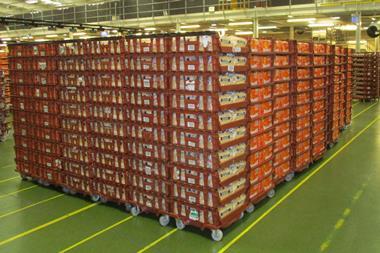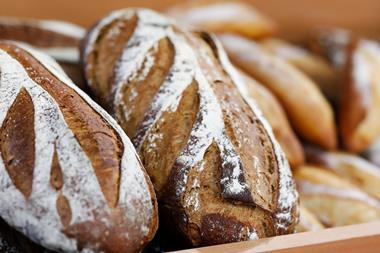Sue Springett, commercial manager at furniture and equipment supplier Teknomek, on the action bakeries will have to take to reduce risk in manufacturing facilities.
In the wake of Covid-19, the bakery sector has needed to scramble to protect the health of its staff while minimising disruption to the supply chain. The conversation is now shifting to the easing of lockdown and a return to ‘business as usual’. Unfortunately, we need to be pragmatic and accept that not all emergency best-practice will be temporary.
Reducing risk has meant increased expenditure on the likes of additional wash troughs, bins, screens, deep cleaning etc, as well as changes to working procedures in line with the BRC’s guidelines.
Social distancing and one-way systems within facilities are likely to remain for the foreseeable future. This will put additional pressure on the bottom line, and it is unlikely customers will be willing to swallow any costs passed on.
There’s no way round it – setting new procedures with the tools to support compliance will require a substantial chunk of capital expenditure for businesses both large and small. However, once in place you can look to ways to reduce operational costs through streamlining processes wherever possible.
Limited space creates challenges, but they can be overcome
The greatest challenge for many sites lies in maintaining social distancing when space is limited by the structure itself or by immovable production equipment such as conveyor belts, ovens or mixing machines. The first step is to identify where the greatest areas of risk are and put mitigation measures in place. This may mean introducing directional lanes or one-way systems in cramped areas.
Changing rooms are often a problem area as it can be hard to safely accommodate people with sufficient space for social distancing. This problem is compounded if staff are rushing at the start and ends of shifts. If possible, repurpose vacant space to create additional changing rooms – we’ve even heard of production units using marquees and portacabins.
If these aren’t viable solutions, the alternatives are to extend the production day by staggering the start of each shift or reduce the production range so levels can be maintained with fewer staff. Each option should be assessed carefully for its longer-term business impacts.
There are simple hacks that can be applied to drive behavioural change
Screens can be installed between staff to protect them if there is not enough room to support social distancing guidelines in production areas. It is also advisable to deploy safe distancing markers and box out individual working zones with safety tape.
There are simple hacks that can be applied to drive behavioural change too. For instance, reduce clustering by installing multiple single-person PPE dispensers around a room at safe distances. Similarly, replace or limit the use of multiple-station hand-washing points, instead install single units in line with social distancing guidelines. Support this by making sure there are sufficient waste bins deployed alongside paper towel dispensers to reduce cross-contamination risk.
It is also important to reinforce social distancing and hygiene best practice guidelines through signage. Set wall reminders in appropriate areas, notably locker rooms, changeover, washrooms and in production areas. Remember, everyone responds better to particular prompts, so if you have a Tannoy system make use of it, for example at the start and end of shifts.
Managing the human factor
Of course, you have to rely on your staff’s common sense but managing the human factor will always be the greatest risk challenge.
Make it as easy as possible for people to do the right thing. Use hands-free options wherever possible. Each time a touch point is removed, another risk is managed away. Upgrade standard taps and soap dispensers to infrared or knee operated. If doors are not motion sensor controlled, replace standard handles with sanitising ones that release viricidal gel on contact.
Also assign ownership to reduce any risks of unwitting transference. Clearly label clothing and return it to the individual’s personal lockers and lockable boot racks after cleaning. The same is true for PPE such as visors, as deploying reusable PPE can be more cost effective than single use. It just takes a little extra care to ensure it remains with the designated user.
By the same token, ensure knives, cutting boards and other equipment is colour coded to ensure it stays within the assigned production zone.
Keep it clean
The World Health Organisation has advised the coronavirus ‘may persist on surfaces for a few hours or up to several days’. It goes without saying that cleaning procedures will need to be upgraded for the foreseeable future. This will have a significant impact on a business’ running expenses but can be managed by cleaning smarter.
When it comes to cleaning materials, it’s worthwhile looking at new technologies being introduced that are anti-viricidal as well as anti-microbial
The first step should always be to remove any furniture that’s not currently in use; not only does this reduce risk, it will also cut cleaning times. When it comes to cleaning materials, it’s worthwhile looking at new technologies being introduced that are anti-viricidal as well as anti-microbial.
The surfaces of food-grade furniture should be anti-microbial as standard but look out for ‘trap points’ – unnecessary ingresses, ledges and even raised welds – that require contact when cleaning. As well as increasing transference risk, any items that are fiddly represent a higher operating expense to the business over time. Assess how long each item takes to clean and if anything takes markedly longer, it will likely be more cost-effective to replace it.
Given the state of economy, any supplemental investment may feel counterintuitive at this time. However, during a period of heightened sensitivities it is important to reassure customers and colleagues. As such, businesses within this sector should take the pandemic as an opportunity to reset, upgrade and embed the highest levels of food safety culture best-practice.
While the European Food Safety Authority has determined that coronavirus is not foodborne, any additional investment in hygiene control will help future-proof your business against risks from pathogens such as campylobacter and salmonella.
As we’ve seen, the key to success is not just to do more, it’s to do it smarter – and that’s simply good business practice.














































No comments yet